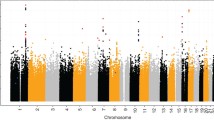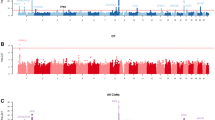Abstract
This study examined the association between markers in transforming growth factor alpha (TGFA) and isolated, non-syndromic cleft lip with/without palate (CL/P) using a case–parent trio design, considering parent-of-origin effects. We also tested for gene–environmental interaction with common maternal exposures, and for gene–gene interaction using markers in TGFA and another recognized causal gene, IRF6. CL/P case–parent trios from four populations (76 from Maryland, 146 from Taiwan, 35 from Singapore, and 40 from Korea) were genotyped for 17 single nucleotide polymorphisms (SNPs) in TGFA. The transmission disequilibrium test was used to test individual SNPs, and the parent-of-origin likelihood ratio test (PO-LRT) was used to assess parent-of-origin effects. We also screened for possible gene–environment interaction using PBAT, and tested for gene–gene interaction using conditional logistic regression models. When all trios were combined, four SNPs showed significant excess maternal transmission, two of which gave significant PO-LRT values [rs3821261: P = 0.004 and OR(imprinting) = 4.17; and rs3771475: P = 0.027 and OR(imprinting) = 2.44]. Haplotype analysis of these two SNPS also supported excess maternal transmission. We saw intriguing but suggestive evidence of G × E interaction for several SNPs in TGFA when either individual SNPs or haplotypes of adjacent SNPs were considered. Thus, TGFA appears to influence risk of CL/P through unconventional means with an apparent parent-of-origin effect (excess maternal transmission) and possible interaction with maternal exposures.


Similar content being viewed by others
References
Ardinger HH, Buetow KH, Bell GI, Bardach J, VanDemark DR, Murray JC (1989) Association of genetic variation of the transforming growth factor-alpha gene with cleft lip and palate. Am J Hum Genet 45:348–353
Barrett JC, Fry B, Maller J, Daly MJ (2005) Haploview: analysis and visualization of LD and haplotype maps. Bioinformatics 21:263–265
Beaty TH, Maestri NE, Hetmanski JB, Wyszynski DF, Vanderkolk CA, Simpson JC, McIntosh I, Smith EA, Zeiger JS, Raymond GV, Panny SR, Tifft CJ, Lewanda AF, Cristion CA, Wulfsberg EA (1997) Testing for interaction between maternal smoking and TGFA genotype among oral cleft cases born in Maryland 1992–1996. Cleft Palate Craniofac J 34:447–454
Beaty TH, Hetmanski JB, Fallin MD, Park JW, Sull JW, McIntosh I, Liang KY, Vanderkolk CA, Redett RJ, Boyadjiev SA, Jabs EW, Chong SS, Cheah FS, Wu-Chou YH, Chen PK, Chiu YF, Yeow V, Ng IS, Cheng J, Huang S, Ye X, Wang H, Ingersoll R, Scott AF (2006) Analysis of candidate genes on chromosome 2 in oral cleft case–parent trios from three populations. Hum Genet 120:501–518
Becker T, Knapp M (2004) Maximum-likelihood estimation of haplotype frequencies in nuclear families. Genet Epidemiol 27:21–32
Becker T, Baur MP, Knapp M (2006) Detection of parent-of-origin effects in nuclear families using haplotype analysis. Hum Hered 62:64–76
Bellus GA, Hefferon TW, Ortiz de Luna RI, Hecht JT, Horton WA, Machado M, Kaitila I, McIntosh I, Francomano CA (1995) Achondroplasia is defined by recurrent G380R mutations of FGFR3. Am J Hum Genet 56:368–373
Christensen K, Mitchell LE (1996) Familial recurrence-pattern analysis of nonsyndromic isolated cleft palate—a Danish Registry study. Am J Hum Genet 58:182–190
Cobourne MT (2004) The complex genetics of cleft lip and palate. Eur J Orthod 26:7–16
Cordell HJ, Barratt BJ, Clayton DG (2004) Case/pseudocontrol analysis in genetic association studies: a unified framework for detection of genotype and haplotype associations, gene–gene and gene–environment interactions, and parent-of-origin effects. Genet Epidemiol 26:167–185
Fan JB, Oliphant A, Shen R, Kermani BG, Garcia F, Gunderson KL, Hansen M, Steemers F, Butler SL, Deloukas P, Galver L, Hunt S, McBride C, Bibikova M, Rubano T, Chen J, Wickham E, Doucet D, Chang W, Campbell D, Zhang B, Kruglyak S, Bentley D, Haas J, Rigault P, Zhou L, Stuelpnagel J, Chee MS (2003) Highly parallel SNP genotyping. Cold Spring Harb Symp Quant Biol 68:69–78
Hwang SJ, Beaty TH, Panny SR, Street NA, Joseph JM, Gordon S, McIntosh I, Francomano CA (1995) Association study of transforming growth factor alpha (TGF alpha) TaqI polymorphism and oral clefts: indication of gene–environment interaction in a population-based sample of infants with birth defects. Am J Epidemiol 141:629–636
Ioannidis JP, Ntzani EE, Trikalinos TA, Contopoulos-Ioannidis DG (2001) Replication validity of genetic association studies. Nat Genet 29:306–309
Jugessur A, Lie RT, Wilcox AJ, Murray JC, Taylor JA, Saugstad OD, Vindenes HA, Abyholm F (2003a) Variants of developmental genes (TGFA, TGFB3, and MSX1) and their associations with orofacial clefts: a case–parent triad analysis. Genet Epidemiol 24:230–239
Jugessur A, Lie RT, Wilcox AJ, Murray JC, Taylor JA, Saugstad OD, Vindenes HA, Abyholm FE (2003b) Cleft palate, transforming growth factor alpha gene variants, and maternal exposures: assessing gene–environment interactions in case–parent triads. Genet Epidemiol 25:367–374
Knapp M, Becker T (2003) Family-based association analysis with tightly linked markers. Hum Hered 56:2–9
Maestri NE, Beaty TH, Hetmanski J, Smith EA, McIntosh I, Wyszynski DF, Liang KY, Duffy DL, VanderKolk C (1997) Application of transmission disequilibrium tests to nonsyndromic oral clefts: including candidate genes and environmental exposures in the models. Am J Med Genet 73:337–344
Miettinen PJ, Chin JR, Shum L, Slavkin HC, Shuler CF, Derynck R, Werb Z (1999) Epidermal growth factor receptor function is necessary for normal craniofacial development and palate closure. Nat Genet 22:69–73
Nyholt DR (2004) A simple correction for multiple testing for single-nucleotide polymorphisms in linkage disequilibrium with each other. Am J Hum Genet 74:765–769
Oliphant A, Barker DL, Stuenlpnagel JR, Chee MS (2002) BeadArray™ Technology: enabling an accurate, cost-efficient approach to high-throughput genotyping. Biotechniques 32:S56–S61
Park JW, McIntosh I, Hetmanski JB, Jabs EW, Vander Kolk CA, Wu-Chou YH, Chen PK, Chong SS, Yeow V, Jee SH, Park BY, Fallin MD, Ingersoll R, Scott AF, Beaty TH (2007) Association between IRF6 and nonsyndromic cleft lip with or without cleft palate in four populations. Genet Med 9:219–227
Rubini M, Brusati R, Garattini G, Magnani C, Liviero F, Bianchi F, Tarantino E, Massei A, Pollastri S, Carturan S, Amadori A, Bertagnin E, Cavallaro A, Fabiano A, Franchella A, Calzolari E (2005) Cystathionine beta-synthase c.844ins68 gene variant and non-syndromic cleft lip and palate. Am J Med Genet A 136:368–372
Salyakina D, Seaman SR, Browning BL, Dudbridge F, Muller-Myhsok B (2005) Evaluation of Nyholt’s procedure for multiple testing correction. Hum Hered 60:19–25
Shaw GM, Wasserman CR, Lammer EJ, O’Malley CD, Murray JC, Basart AM, Tolarova MM (1996) Orofacial clefts, parental cigarette smoking, and transforming growth factor-alpha gene variants. Am J Hum Genet 58:551–561
Shaw GM, Wasserman CR, Murray JC, Lammer EJ (1998) Infant TGF-alpha genotype, orofacial clefts, and maternal periconceptional multivitamin use. Cleft Palate Craniofac J 35:366–370
Sinsheimer JS, Palmer CG, Woodward JA (2003) Detecting genotype combinations that increase risk for disease: maternal–fetal genotype incompatibility test. Genet Epidemiol 24:1–13
Spielman RS, McGinnis RE, Ewens WJ (1993) Transmission test for linkage disequilibrium: the insulin gene region and insulin-dependent diabetes mellitus (IDDM). Am J Hum Genet 52:506–516
Starr JR, Hsu L, Schwartz SM (2005) Assessing maternal genetic associations: a comparison of the log-linear approach to case–parent triad data and a case–control approach. Epidemiology 16:294–303
Sull JW, Liang KY, Hetmanski JB, Fallin MD, Ingersoll RG, Park J, Wu-Chou YH, Chen PK, Chong SS, Cheah F, Yeow V, Park BY, Jee SH, Jabs EW, Redett R, Jung E, Ruczinski I, Scott AF, Beaty TH (2008) Differential parental transmission of markers in RUNX2 among cleft case–parent trios from four populations. Genet Epidemiol 32:505–512
Tricoli JV, Nakai H, Byers MG, Rall LB, Bell GI, Shows TB (1986) The gene for human transforming growth factor alpha is on the short arm of chromosome 2. Cytogenet Cell Genet 42:94–98
van Den Oord EJ, Vermunt JK (2000) Testing for linkage disequilibrium, maternal effects, and imprinting with (in)complete case–parent triads, by use of the computer program LEM. Am J Hum Genet 66:335–338
van Rooij IA, Vermeij-Keers C, Kluijtmans LA, Ocké MC, Zielhuis GA, Goorhuis-Brouwer SM, van der Biezen JJ, Kuijpers-Jagtman AM, Steegers-Theunissen RP (2003) Does the interaction between maternal folate intake and the methylenetetrahydrofolate reductase polymorphisms affect the risk of cleft lip with or without cleft palate? Am J Epidemiol 157:583–591
Vansteelandt S, Demeo DL, Lasky-Su J, Smoller JW, Murphy AJ, McQueen M, Schneiter K, Celedon JC, Weiss ST, Silverman EK, Lange C (2007) Testing and estimating gene–environment interactions in family-based association studies. Biometrics 64:458–467
Vieira AR (2006) Association between the transforming growth factor alpha gene and nonsyndromic oral clefts: a HuGE review. Am J Epidemiol 163:790–810
Vieira AR, Modesto A, Meira R, Barbosa AR, Lidral AC, Murray JC (2007) Interferon regulatory factor 6 (IRF6) and fibroblast growth factor receptor 1 (FGFR1) contribute to human tooth agenesis. Am J Med Genet A 143:538–545
Weinberg CR (1999) Methods for detection of parent-of-origin effects in genetic studies of case–parents triads. Am J Hum Genet 65:229–235
Weinberg CR, Umbach DM (2005) A hybrid design for studying genetic influences on risk of diseases with onset early in life. Am J Hum Genet 77:627–636
Wilkins JF, Haig D (2003) What good is genomic imprinting: the function of parent-specific gene expression. Nat Rev Genet 4:359–368
Wyszynski DF, Duffy DL, Beaty TH (1997) Maternal cigarette smoking and oral clefts: a meta-analysis. Cleft Palate Craniofac J 34:206–210
Zeiger JS, Beaty TH, Liang KY (2005) Oral clefts, maternal smoking, and TGFA: a meta-analysis of gene-environment interaction. Cleft Palate Craniofac J 42:58–63
Zhao H, Zhang S, Merikangas KR, Trixler M, Wildenauer DB, Sun F, Kidd KK (2000) Transmission/disequilibrium tests using multiple tightly linked markers. Am J Hum Genet 67:936–946
Zucchero TM, Cooper ME, Maher BS, Daack-Hirsch S, Nepomuceno B, Ribeiro L, Caprau D, Christensen K, Suzuki Y, Machida J, Natsume N, Yoshiura K, Vieira AR, Orioli IM, Castilla EE, Moreno L, Arcos-Burgos M, Lidral AC, Field LL, Liu YE, Ray A, Goldstein TH, Schultz RE, Shi M, Johnson MK, Kondo S, Schutte BC, Marazita ML, Murray JC (2004) Interferon regulatory factor 6 (IRF6) gene variants and the risk of isolated cleft lip or palate. N Engl J Med 351:769–780
Acknowledgments
This research was supported by R21-DE-013707 and R01-DE-014581 from the National Institute of Dental & Craniofacial Research, NIH R01 HL 090577, Korean Research Foundation (2005-214-E00042), and the Seoul City R&BD program (10526) in Korea. We thank all participants who donated samples for this multi-center study of oral clefts, as well as the staff at each participating site and institution. We also thank Gerald Raymond for his assistance in screening patients at Hopkins.
Author information
Authors and Affiliations
Corresponding author
Rights and permissions
About this article
Cite this article
Sull, J.W., Liang, KY., Hetmanski, J.B. et al. Evidence that TGFA influences risk to cleft lip with/without cleft palate through unconventional genetic mechanisms. Hum Genet 126, 385–394 (2009). https://doi.org/10.1007/s00439-009-0680-3
Received:
Accepted:
Published:
Issue Date:
DOI: https://doi.org/10.1007/s00439-009-0680-3




